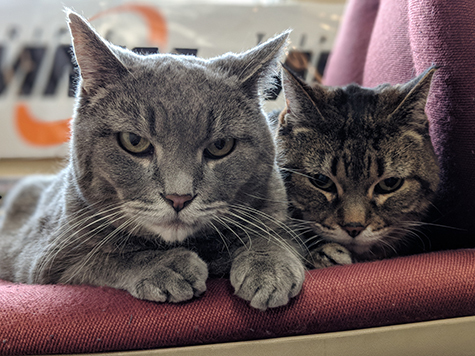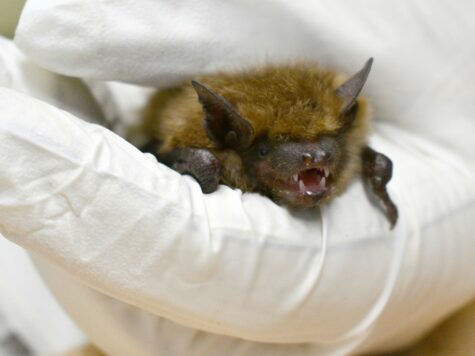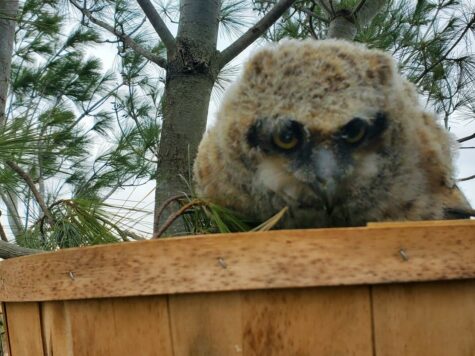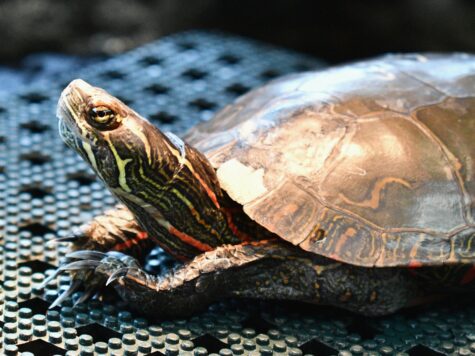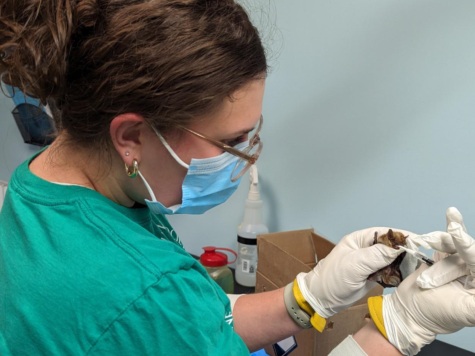Cats can be finicky, mysterious creatures, and it can sometimes be hard to figure out why cats are acting the way that they are. It might help to take a step back and really analyze what behaviors your cat is showing, and put yourself in their paws and see how they’re living their life in your home.
Signs of a grumpy cat:
Cats tend to do most of their communication with people through body language. As people, we tend to focus the most on vocalizations, but some signals can be missed just because we’re maybe not watching as closely as we could. The following are some body language cues that may be your cat trying to tell you that they’re frustrated:
- Constricted or dilated pupils
- Un-blinking stares
- Sideways or flat ears
- Tucked tail, thumping/whipping tail, and/or piloerect body/tail (when the hail along their spine is standing up)
- Growling, hissing, and/or chuffing
- Lip-licking
- Excessive grooming or shedding
- Excessive scratching/clawing of living space
- Excessive vocalization
All cats express fear or discontent at one point or another, but most happy, comfortable cats aren’t showing this type of behavior very frequently. If you’re noticing your cat exhibiting these behaviors often, they might be trying to tell you that something is wrong.
Potential fixes:
It might feel incredibly frustrating to not be able to quickly figure out what your cat likes or doesn’t like. Before you give up on little Simba, there are some things you can re-evaluate around your home that might help calm your kitty down:
- Cats need playtime! Some mini-panthers enjoy playing solo, but a lot of cats prefer playing with their favorite people. Even though they may live inside and have a squishy bed, cats still have hunting instincts that need to be met. Depending on the age and the temperament of the cat, different cats have different playing needs. Maybe your micro-lion needs some more action!
- Cats THRIVE on routine, and some have a harder time adjusting to new routines or living spaces than others. We preach our “Rule of 3” as the timeline for most cats, but some felines need you to slow things down even further. Your kitty could also be stressed out by new pet, adult, and/or children additions to their lives. Be patient! Give your kitty the time to adjust that they need and it’ll totally pay off in the end!
- Cats have very specific needs and expectations of their litterbox(es), but aren’t able to tell us what those expectations are. If you think your feline friend is frustrated with their bathroom arrangement, try some trial-and-error of different options: different litter, more boxes, bigger boxes, taller/covered boxes, different locations, or scooping more frequently. Eventually, you should be able to come up with a magic formula of litter and boxes to make your kitty’s potty experiences ideal!
- Without physical external symptoms, it can be hard to tell if your cat might have a medical issue. Cats who are not spayed or neutered may act out due to the high level of hormones, especially during the warmer months when cats tend to reproduce. Cats who have undergone a declaw surgery might be having a hard time adjusting to the loss of their knuckles and may need a re-check with your vet. Cats who develop matted fur might be grumpier due to not being able to remove the mat themselves or because of how painfully tight the mat is. Grumpy cat behavior could also mean more severe health issues, so it’s always good to check in with your vet if you feel like your cat’s home environment isn’t the issue.
Signs of a content kitty:
Once you feel like you’ve solved the Mystery of the Grumpy Cat, you should start to see your cat acting more relaxed and content. Here are some happy cat body language signs to watch for in your furry roommate:
- Cat giving you slow blinks when they make eye contact
- Upright, forward-facing ears
- Meows, purrs and chirps
- Vertical, erect tail and maybe a full-tail shiver
- Happy paws/making biscuits
- Head-butting
- Scent-marking
- Grooming their people
- Showing their belly
- Raised third eyelids/closed eyes during pets
Ideally, your cat should be this happy in your home all the time. It’s totally natural and understandable that things change and life happens. As long as you remember your cat and take their feelings into account, there shouldn’t be any reason why Tiger can’t thrive with you through all of life’s changes.
